An Experimental Exploration of the Effects of Exposure to Images of Nature on Rumination
Abstract
:1. Introduction
1.1. Rumination
1.2. Restorative Environments
1.3. Why Might Nature Benefit Rumination?
1.4. Hypotheses
2. Method
2.1. Participants
2.1.1. Sample Size and Recruitment
2.1.2. Randomization Procedure
2.2. Materials and Measures
2.2.1. Slideshows
2.2.2. Demographics
2.2.3. Trait Rumination
2.2.4. Connectedness-to-Nature
2.2.5. State Rumination
2.2.6. Mood
2.2.7. Being Away and Fascination
2.2.8. Reliability
2.3. Procedure
2.3.1. Overview
2.3.2. Baseline Procedure
2.3.3. Rumination Induction
2.3.4. Post-Presentation Procedure
2.3.5. Experimental Manipulation
2.3.6. Post-Manipulation Procedure
2.4. Ethics
3. Results
3.1. Missing Data
3.2. Distribution and Baseline Checks
3.3. Mood Manipulation Check
3.4. Main Findings
3.4.1. State Rumination
3.4.2. Positive Mood
3.4.3. Negative Mood
3.4.4. Fascination
3.4.5. Being Away
4. Discussion
Limitations
5. Conclusions
Acknowledgments
Author Contributions
Conflicts of Interest
Appendix A
| Measure | Nature | Built | Control | |||||
|---|---|---|---|---|---|---|---|---|
| M/Mdn (95% CI) | SD/Range | M/Mdn (95% CI) | SD/Range | M/Mdn (95% CI) | SD/Range | F-Ratio/H (df) | p-Value | |
| Age * | 27.00 (24.00, 37.50) | 50 | 25.50 (23.00, 28.00) | 29 | 28.50 (24.00, 41.00) | 45 | 2.93 (2) | 0.23 |
| Positive affect | 32.50 (29.04, 35.96) | 6.96 | 35.75 (32.55, 38.95) | 6.84 | 35.15 (32.68, 37.62) | 5.27 | 1.37 (2, 55) | 0.26 |
| Negative affect | 17.11 (14.02, 20.20) | 6.22 | 20.75 (17.74, 23.76) | 6.43 | 17.70 (15.19, 20.21) | 5.37 | 2.05 (2, 55) | 0.14 |
| Connectedness-to-nature | 48.89 (45.34, 52.44) | 7.13 | 49.00 (45.41, 52.59) | 7.66 | 50.00 (46.43, 53.57) | 7.64 | 0.13 (2, 55) | 0.88 |
| Trait rumination | 47.11 (41.38, 52.84) | 11.52 | 49.20 (44.20, 54.20) | 10.68 | 47.00 (42.08, 51.92) | 10.52 | 0.26 (2, 55) | 0.78 |
Appendix B
| Measure | Nature | Built | Control | |||||
|---|---|---|---|---|---|---|---|---|
| M/Mdn (95% CI) | SD/Range | M/Mdn (95% CI) | SD/Range | M/Mdn (95% CI) | SD/Range | F-Ratio/H (df) | p-Value | |
| Positive affect | 28.06 (24.83, 31.28) | 6.49 | 29.55 (25.98, 33.12) | 7.62 | 27.60 (23.55, 31.65) | 8.65 | 0.35 (2, 55) | 0.71 |
| Negative affect * | 16.00 (12.00, 18.99) | 31 | 15.00 (12.01, 18.00) | 23 | 14.00 (13.00, 16.00) | 24 | 0.37 (2) | 0.83 |
| State rumination | 59.56 (53.63, 65.48) | 11.92 | 60.30 (55.59, 65.01) | 10.07 | 59.45 (54.86, 64.04) | 9.80 | 0.04 (2, 55) | 0.96 |
References
- Berman, M.G.; Jonides, J.; Kaplan, S. The cognitive benefits of interacting with nature. Psychol. Sci. 2008, 19, 1207–1212. [Google Scholar] [CrossRef] [PubMed]
- Hartig, T.; Evans, G.W.; Jamner, L.D.; Davis, D.S.; Gärling, T. Tracking restoration in natural and urban field settings. J. Environ. Psychol. 2003, 23, 109–123. [Google Scholar] [CrossRef]
- Velarde, M.D.; Fry, G.; Tveit, M. Health effects of viewing landscapes—Landscape types in environmental psychology. Urban For. Urban Green. 2007, 6, 199–212. [Google Scholar] [CrossRef]
- Brosschot, J.F.; Gerin, W.; Thayer, J.F. The perseverative cognition hypothesis: A review of worry, prolonged stress-related physiological activation, and health. J. Psychosom. Res. 2006, 60, 113–124. [Google Scholar] [CrossRef] [PubMed]
- Nolen-Hoeksema, S. Responses to depression and their effects on the duration of depressive episodes. J. Abnorm. Psychol. 1991, 100, 569–582. [Google Scholar] [CrossRef] [PubMed]
- Nolen-Hoeksema, S.; Wisco, B.E.; Lyubomirsky, S. Rethinking rumination. Perspect. Psychol. Sci. 2008, 3, 400–424. [Google Scholar] [CrossRef] [PubMed]
- Mor, N.; Winquist, J. Self-focused attention and negative affect: A meta-analysis. Psychol. Bull. 2002, 128, 638–662. [Google Scholar] [CrossRef] [PubMed]
- Muris, P.; Roelofs, J.; Rassin, E.; Franken, I.; Mayer, B. Mediating effects of rumination and worry on the links between neuroticism, anxiety and depression. Personal. Individ. Differ. 2005, 39, 1105–1111. [Google Scholar] [CrossRef]
- Nolen-Hoeksema, S. The role of rumination in depressive disorders and mixed anxiety/depressive symptoms. J. Abnorm. Psychol. 2000, 109, 504–511. [Google Scholar] [CrossRef] [PubMed]
- Cropley, M.; Millward Purvis, L. Job strain and rumination about work issues during leisure time: A diary study. Eur. J. Work Organ. Psychol. 2003, 12, 195–207. [Google Scholar] [CrossRef] [Green Version]
- Cropley, M.; Zijlstra, F.R.H. Work and rumination. In Handbook of Stress in the Occupations; Langan-Fox, J., Cooper, C.L., Eds.; Edward Elgar: Cheltenham, UK, 2011; pp. 487–501. ISBN 9780857931146. [Google Scholar]
- Berset, M.; Elfering, A.; Lüthy, S.; Lüthi, S.; Semmer, N.K. Work stressors and impaired sleep: Rumination as a mediator. Stress Health 2011, 27, e71–e82. [Google Scholar] [CrossRef] [PubMed]
- Cropley, M.; Dijk, D.-J.; Stanley, N. Job strain, work rumination, and sleep in school teachers. Eur. J. Work Organ. Psychol. 2006, 15, 181–196. [Google Scholar] [CrossRef] [Green Version]
- Querstret, D.; Cropley, M. Exploring the relationship between work-related rumination, sleep quality, and work-related fatigue. J. Occup. Health Psychol. 2012, 17, 341–353. [Google Scholar] [CrossRef] [PubMed] [Green Version]
- Nolen-Hoeksema, S.; Harrell, Z.A. Rumination, depression, and alcohol use: Tests of gender differences. J. Cogn. Psychother. 2002, 16, 391–403. [Google Scholar] [CrossRef]
- Key, B.L.; Campbell, T.S.; Bacon, S.L.; Gerin, W. The influence of trait and state rumination on cardiovascular recovery from a negative emotional stressor. J. Behav. Med. 2008, 31, 237–248. [Google Scholar] [CrossRef] [PubMed]
- Zoccola, P.M.; Figueroa, W.S.; Rabideau, E.M.; Woody, A.; Benencia, F. Differential effects of poststressor rumination and distraction on cortisol and C-reactive protein. Health Psychol. 2014, 33, 1606–1609. [Google Scholar] [CrossRef] [PubMed]
- Zoccola, P.M.; Dickerson, S.S. Assessing the relationship between rumination and cortisol: A review. J. Psychosom. Res. 2012, 73, 1–9. [Google Scholar] [CrossRef] [PubMed]
- Andrews, M.; Gatersleben, B. Variations in perceptions of danger, fear and preference in a simulated natural environment. J. Environ. Psychol. 2010, 30, 473–481. [Google Scholar] [CrossRef] [Green Version]
- Gatersleben, B.; Andrews, M. When walking in nature is not restorative—The role of prospect and refuge. Health Place 2013, 20, 91–101. [Google Scholar] [CrossRef] [PubMed] [Green Version]
- Herzog, T.R.; Ouellette, P.; Rolens, J.R.; Koenigs, A.M. Houses of worship as restorative environments. Environ. Behav. 2009, 42, 395–419. [Google Scholar] [CrossRef]
- Ouellette, P.; Kaplan, R.; Kaplan, S. The monastery as a restorative environment. J. Environ. Psychol. 2005, 25, 175–188. [Google Scholar] [CrossRef]
- Berman, M.G.; Kross, E.; Krpan, K.M.; Askren, M.K.; Burson, A.; Deldin, P.J.; Kaplan, S.; Sherdell, L.; Gotlib, I.H.; Jonides, J. Interacting with nature improves cognition and affect for individuals with depression. J. Affect. Disord. 2012, 140, 300–305. [Google Scholar] [CrossRef] [PubMed]
- Hartig, T.; Mang, M.; Evans, G.W. Restorative effects of natural environment experiences. Environ. Behav. 1991, 23, 3–26. [Google Scholar] [CrossRef]
- Tyrväinen, L.; Ojala, A.; Korpela, K.; Lanki, T.; Tsunetsugu, Y.; Kagawa, T. The influence of urban green environments on stress relief measures: A field experiment. J. Environ. Psychol. 2014, 38, 1–9. [Google Scholar] [CrossRef]
- Ulrich, R.S.; Simons, R.F.; Losito, B.D.; Fiorito, E.; Miles, M.A.; Zelson, M. Stress recovery during exposure to natural and urban environments. J. Environ. Psychol. 1991, 11, 201–230. [Google Scholar] [CrossRef]
- Van den Berg, A.E.; Koole, S.L.; van der Wulp, N.Y. Environmental preference and restoration: (How) are they related? J. Environ. Psychol. 2003, 23, 135–146. [Google Scholar] [CrossRef]
- Bowler, D.E.; Buyung-Ali, L.M.; Knight, T.M.; Pullin, A.S. A systematic review of evidence for the added benefits to health of exposure to natural environments. BMC Public Health 2010, 10, 456. [Google Scholar] [CrossRef] [PubMed]
- Gonzalez, M.T.; Hartig, T.; Patil, G.G.; Martinsen, E.W.; Kirkevold, M. Therapeutic horticulture in clinical depression: A prospective study. Res. Theory Nurs. Pract. 2009, 23, 312–328. [Google Scholar] [CrossRef] [PubMed]
- Ulrich, R.S. View through a window may influence recovery from surgery. Science 1984, 224, 420–421. [Google Scholar] [CrossRef] [PubMed]
- Pretty, J.; Peacock, J.; Hine, R.; Sellens, M.; South, N.; Griffin, M. Green exercise in the UK countryside: Effects on health and psychological well-being, and implications for policy and planning. J. Environ. Plan. Manag. 2007, 50, 211–231. [Google Scholar] [CrossRef]
- Taylor, A.F.; Kuo, F.E. Children with attention deficits concentrate better after walk in the park. J. Atten. Disord. 2009, 12, 402–409. [Google Scholar] [CrossRef] [PubMed]
- Ohly, H.; White, M.P.; Wheeler, B.W.; Bethel, A.; Ukoumunne, O.C.; Nikolaou, V.; Garside, R. Attention restoration theory: A systematic review of the attention restoration potential of exposure to natural environments. J. Toxicol. Environ. Health Part B 2016, 19, 305–343. [Google Scholar] [CrossRef] [PubMed]
- Ulrich, R.S. Aesthetic and affective response to natural environment. In Behavior and the Natural Environment; Altman, I., Wohlwill, J.F., Eds.; Plenum Press: New York, NY, USA, 1983; pp. 85–125. ISBN 9781461335412. [Google Scholar]
- Kaplan, S.; Kaplan, R. The restorative environment. In The Experience of Nature: A Psychological Perspective; Cambridge University Press: Cambridge, UK; New York, NY, USA, 1989; pp. 177–200. ISBN 0521349397. [Google Scholar]
- Kaplan, S. The restorative benefits of nature: Toward an integrative framework. J. Environ. Psychol. 1995, 15, 169–182. [Google Scholar] [CrossRef]
- McLaughlin, K.A.; Borkovec, T.D.; Sibrava, N.J. The effects of worry and rumination on affect states and cognitive activity. Behav. Ther. 2007, 38, 23–38. [Google Scholar] [CrossRef] [PubMed]
- Huffziger, S.; Ebner-Priemer, U.; Eisenbach, C.; Koudela, S.; Reinhard, I.; Zamoscik, V.; Kirsch, P.; Kuehner, C. Induced ruminative and mindful attention in everyday life: An experimental ambulatory assessment study. J. Behav. Ther. Exp. Psychiatry 2013, 44, 322–328. [Google Scholar] [CrossRef] [PubMed]
- Huffziger, S.; Ebner-Priemer, U.; Koudela, S.; Reinhard, I.; Kuehner, C. Induced rumination in everyday life: Advancing research approaches to study rumination. Personal. Individ. Differ. 2012, 53, 790–795. [Google Scholar] [CrossRef]
- Querstret, D.; Cropley, M. Assessing treatments used to reduce rumination and/or worry: A systematic review. Clin. Psychol. Rev. 2013, 33, 996–1009. [Google Scholar] [CrossRef] [PubMed] [Green Version]
- Kuehner, C.; Huffziger, S.; Liebsch, K. Rumination, distraction and mindful self-focus: Effects on mood, dysfunctional attitudes and cortisol stress response. Psychol. Med. 2009, 39, 219–228. [Google Scholar] [CrossRef] [PubMed]
- Park, R.J.; Goodyer, I.M.; Teasdale, J.D. Effects of induced rumination and distraction on mood and overgeneral autobiographical memory in adolescent Major Depressive Disorder and controls. J. Child Psychol. Psychiatry 2004, 45, 996–1006. [Google Scholar] [CrossRef] [PubMed]
- Huffziger, S.; Kuehner, C. Rumination, distraction, and mindful self-focus in depressed patients. Behav. Res. Ther. 2009, 47, 224–230. [Google Scholar] [CrossRef] [PubMed]
- Gonzalez, M.T.; Hartig, T.; Patil, G.G.; Martinsen, E.W.; Kirkevold, M. Therapeutic horticulture in clinical depression: A prospective study of active components. J. Adv. Nurs. 2010, 66, 2002–2013. [Google Scholar] [CrossRef] [PubMed]
- Faul, F.; Erdfelder, E.; Lang, A.G.; Buchner, A. G*Power 3: A flexible statistical power analysis program for the social, behavioral, and biomedical sciences. Behav. Res. Methods 2007, 39, 175–191. [Google Scholar] [CrossRef] [PubMed]
- Rood, L.; Roelofs, J.; Bögels, S.M.; Arntz, A. The effects of experimentally induced rumination, positive reappraisal, acceptance, and distancing when thinking about a stressful event on affect states in adolescents. J. Abnorm. Child Psychol. 2012, 40, 73–84. [Google Scholar] [CrossRef] [PubMed]
- Urbaniak, G.C.; Plous, S. Research Randomizer (Version 4.0). 2015. Available online: http://www.randomizer.org/ (accessed on 3 June 2015).
- Kim, J.; Shin, W. How to do random allocation (randomization). Clin. Orthop. Surg. 2014, 6, 103–109. [Google Scholar] [CrossRef] [PubMed]
- Alvarsson, J.J.; Wiens, S.; Nilsson, M.E. Stress recovery during exposure to nature sound and environmental noise. Int. J. Environ. Res. Public Health 2010, 7, 1036–1046. [Google Scholar] [CrossRef] [PubMed]
- Ratcliffe, E.; Gatersleben, B.; Sowden, P.T. Bird sounds and their contributions to perceived attention restoration and stress recovery. J. Environ. Psychol. 2013, 36, 221–228. [Google Scholar] [CrossRef]
- Treynor, W.; Gonzalez, R.; Nolen-Hoeksema, S. Rumination reconsidered: A psychometric analysis. Cogn. Ther. Res. 2003, 27, 247–259. [Google Scholar] [CrossRef]
- Mayer, F.S.; Frantz, C.M. The connectedness to nature scale: A measure of individuals’ feeling in community with nature. J. Environ. Psychol. 2004, 24, 503–515. [Google Scholar] [CrossRef]
- Mayer, F.S.; Frantz, C.M.; Bruehlman-Senecal, E.; Dolliver, K. Why is nature beneficial? The role of connectedness to nature. Environ. Behav. 2008, 41, 607–643. [Google Scholar] [CrossRef]
- Edwards, S.L.; Rapee, R.M.; Franklin, J. Postevent rumination and recall bias for a social performance event in high and low socially anxious individuals. Cogn. Ther. Res. 2003, 27, 603–617. [Google Scholar] [CrossRef]
- Zoccola, P.M.; Dickerson, S.S.; Zaldivar, F.P. Rumination and cortisol responses to laboratory stressors. Psychosom. Med. 2008, 70, 661–667. [Google Scholar] [CrossRef] [PubMed]
- Zoccola, P.M.; Dickerson, S.S.; Lam, S. Eliciting and maintaining ruminative thought: The role of social-evaluative threat. Emotion 2012, 12, 673–677. [Google Scholar] [CrossRef] [PubMed]
- Watson, D.; Clark, L.A.; Tellegen, A. Development and validation of brief measures of positive and negative affect: The PANAS scales. J. Personal. Soc. Psychol. 1988, 54, 1063–1070. [Google Scholar] [CrossRef]
- Crawford, J.R.; Henry, J.D. The Positive and Negative Affect Schedule (PANAS): Construct validity, measurement properties and normative data in a large non-clinical sample. Br. J. Clin. Psychol. 2004, 43, 245–265. [Google Scholar] [CrossRef] [PubMed]
- Hartig, T.; Korpela, K.; Evans, G.W.; Gärling, T. A measure of restorative quality in environments. Scand. Hous. Plan. Res. 1997, 14, 175–194. [Google Scholar] [CrossRef]
- Laumann, K.; Gärling, T.; Stormark, K.M. Rating scale measures of restorative components of environments. J. Environ. Psychol. 2001, 21, 31–44. [Google Scholar] [CrossRef]
- Sütterlin, S.; Paap, M.C.S.; Babic, S.; Kübler, A.; Vögele, C. Rumination and age: Some things get better. J. Aging Res. 2012, 267327. [Google Scholar] [CrossRef] [PubMed]
- Nolen-Hoeksema, S.; Jackson, B. Mediators of the gender difference in rumination. Psychol. Women Q. 2001, 25, 37–47. [Google Scholar] [CrossRef]
- Koole, S.L.; van den Berg, A.E. Lost in the wilderness: Terror management, action orientation, and nature evaluation. J. Personal. Soc. Psychol. 2005, 88, 1014–1028. [Google Scholar] [CrossRef] [PubMed]
- Davis, N.; Gatersleben, B. Transcendent experiences in wild and manicured settings: The influence of the trait “Connectedness to Nature”. Ecopsychology 2013, 5, 92–102. [Google Scholar] [CrossRef] [Green Version]
- Watkins, E.R. Constructive and unconstructive repetitive thought. Psychol. Bull. 2008, 134, 163–206. [Google Scholar] [CrossRef] [PubMed]
- Herzog, T.R.; Maguire, P.; Nebel, M.B. Assessing the restorative components of environments. J. Environ. Psychol. 2003, 23, 159–170. [Google Scholar] [CrossRef]
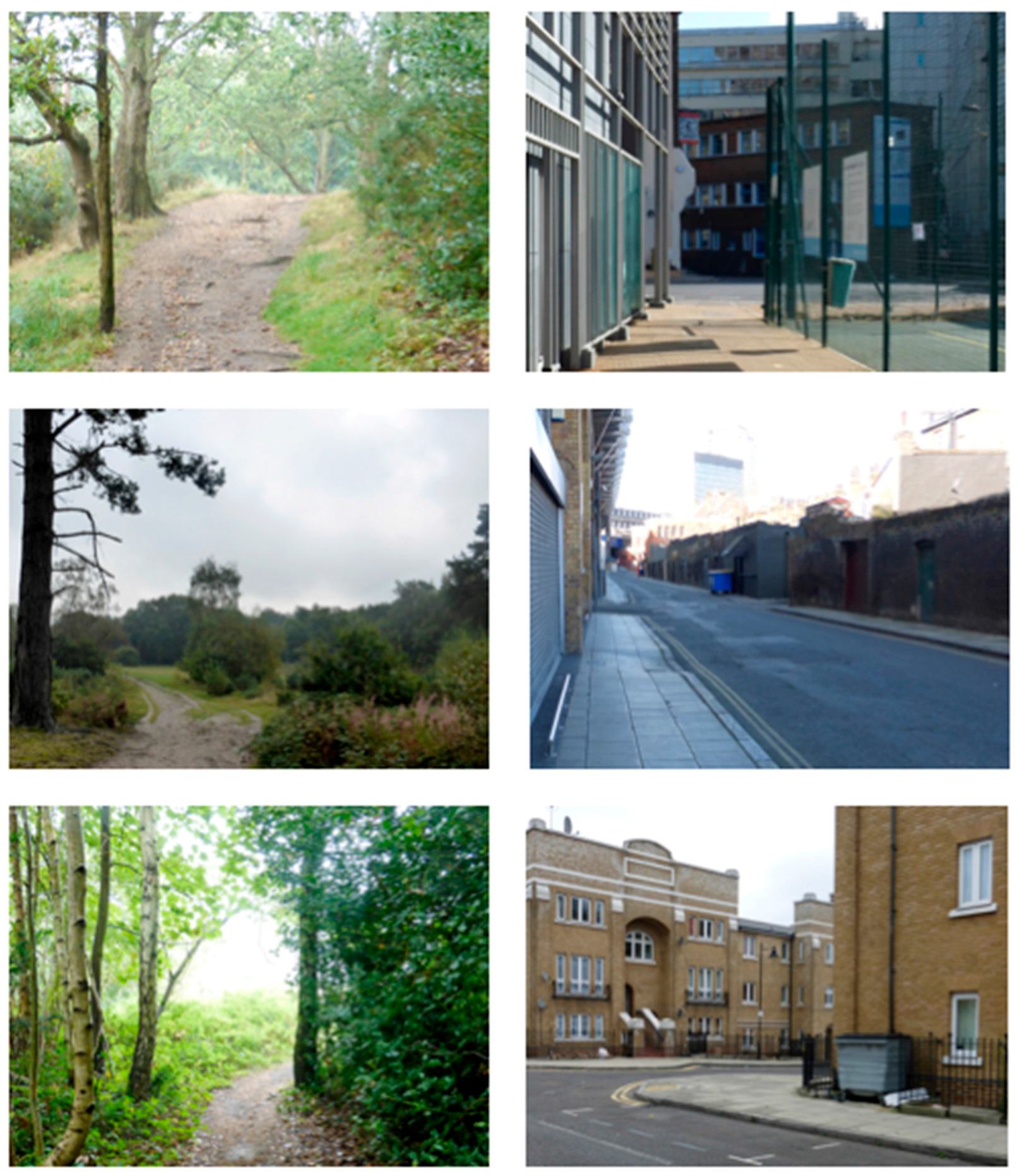

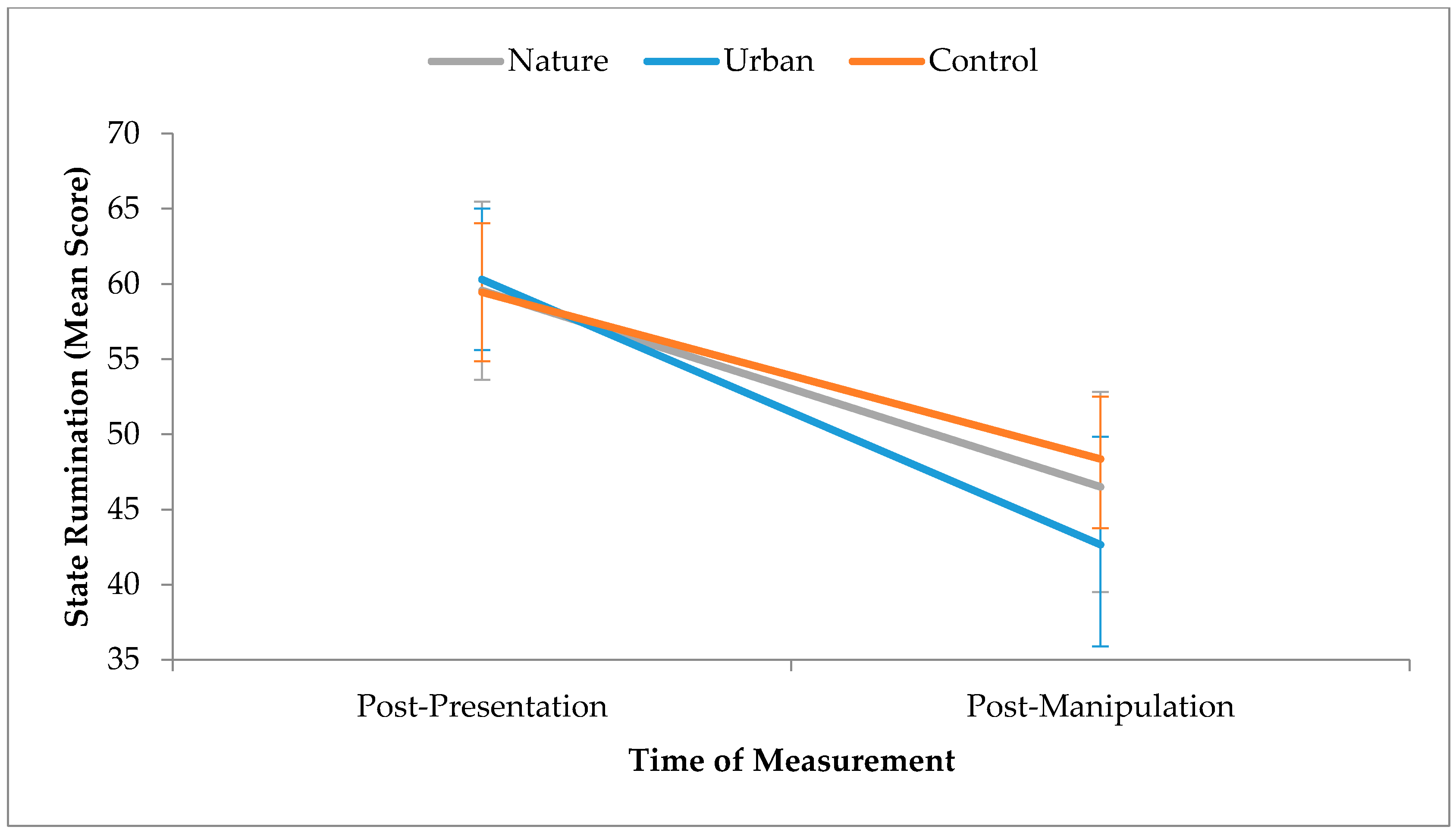
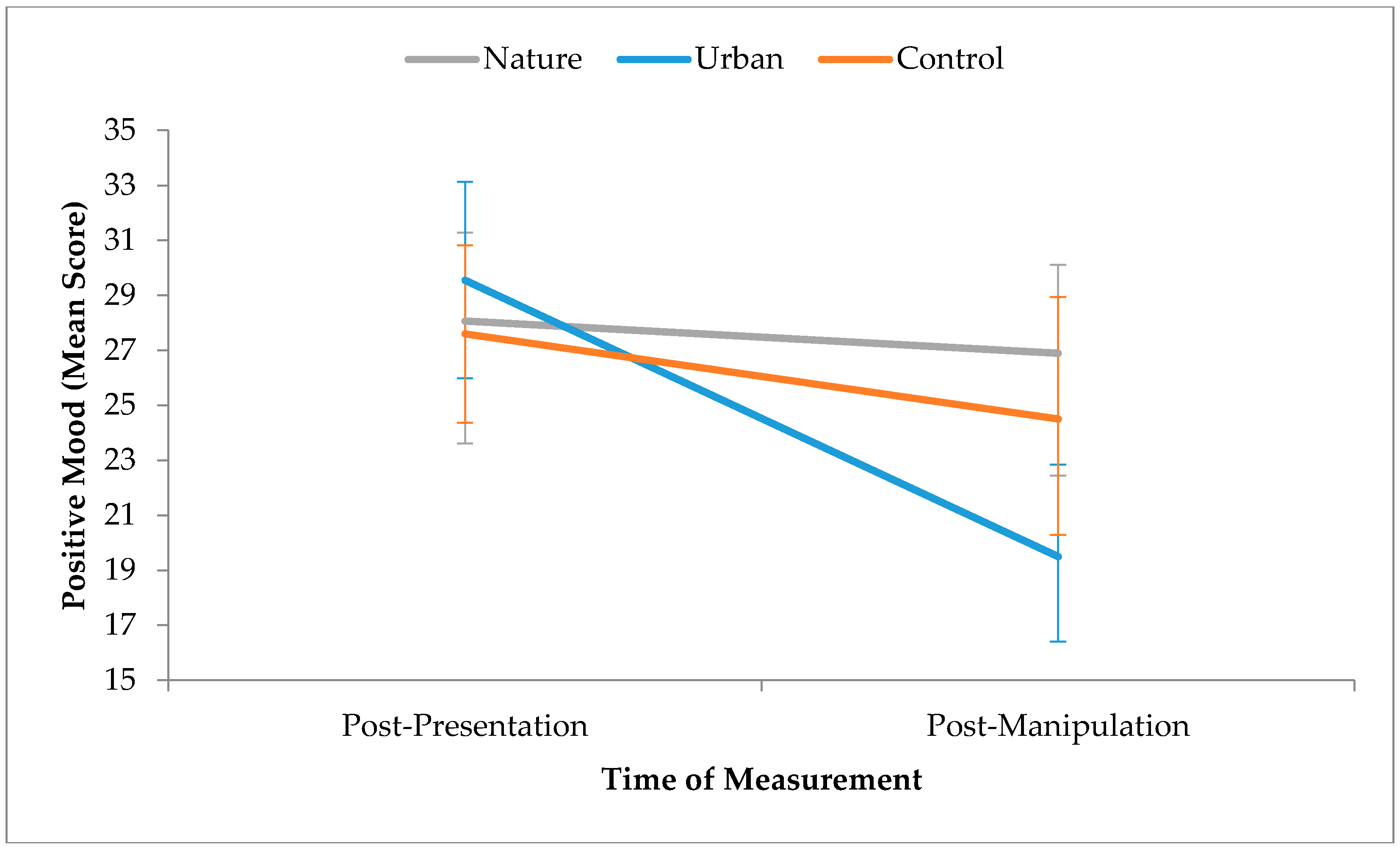
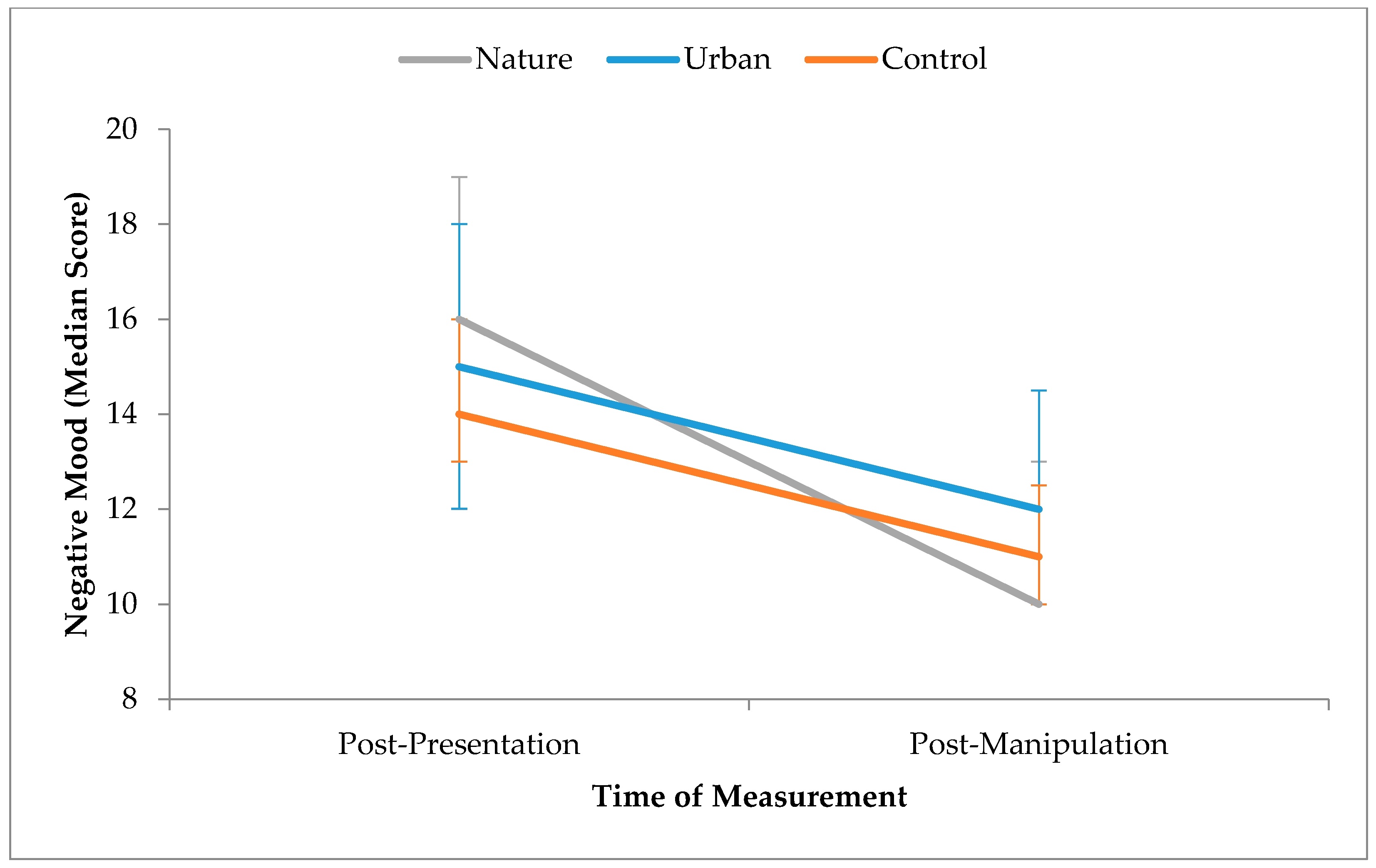
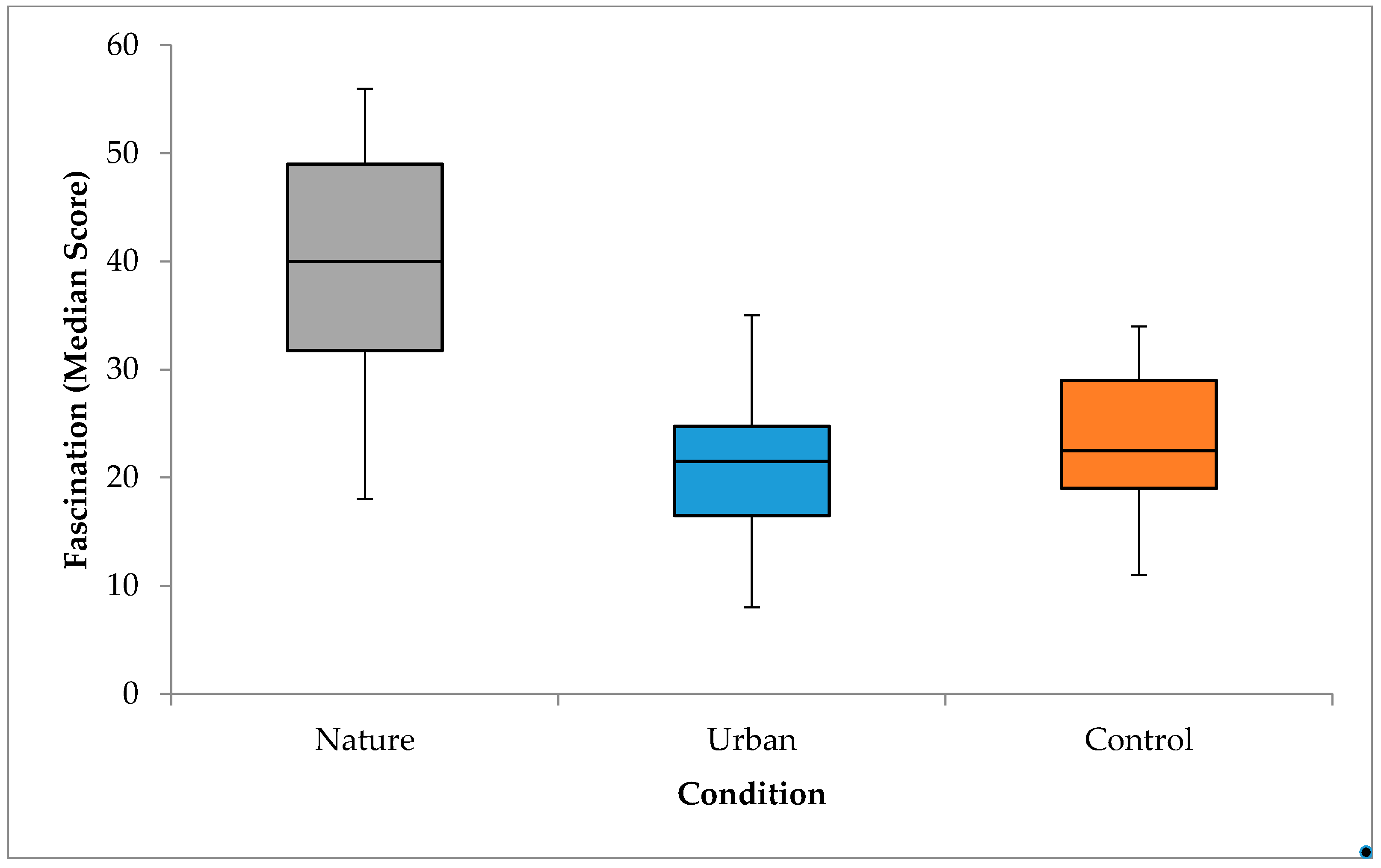

| Characteristic | Individuals in Sample n = 58 | Percentage of Sample | Individuals in Nature Condition n = 18 | Individuals in Built Condition n = 20 | Individuals in Control Condition n = 20 |
|---|---|---|---|---|---|
| Gender | |||||
| Female | 45 | 77.6 | 14 | 15 | 16 |
| Male | 13 | 22.4 | 4 | 5 | 4 |
| Ethnicity * | |||||
| White British | 30 | 51.7 | 9 | 9 | 12 |
| Indian British | 2 | 3.4 | 1 | 0 | 1 |
| Mixed | 4 | 6.9 | 1 | 2 | 1 |
| White Other | 19 | 32.8 | 5 | 8 | 6 |
| Asian Other | 1 | 1.7 | 1 | 0 | 0 |
| Other | 2 | 3.4 | 1 | 1 | 0 |
| Education Level | |||||
| No qualifications | 1 | 1.7 | 1 | 0 | 0 |
| GCSE/O-Level | 5 | 8.6 | 1 | 2 | 2 |
| A-Level/AS-Level | 4 | 6.9 | 0 | 3 | 1 |
| Diploma/HND | 3 | 5.2 | 1 | 0 | 2 |
| Degree | 18 | 31.0 | 5 | 7 | 6 |
| Postgraduate degree/diploma | 27 | 46.6 | 10 | 8 | 9 |
| Marital Status * | |||||
| Single | 17 | 29.3 | 4 | 9 | 4 |
| Dating | 16 | 27.6 | 5 | 6 | 5 |
| Co-habiting | 5 | 8.6 | 1 | 3 | 1 |
| Married/Civil Partnership | 18 | 31.0 | 8 | 2 | 8 |
| Divorced/Separated | 1 | 1.7 | 0 | 0 | 1 |
| Widowed | 1 | 1.7 | 0 | 0 | 1 |
| Employment Status | |||||
| Student | 27 | 46.6 | 6 | 12 | 9 |
| Employed | 30 | 51.7 | 12 | 8 | 10 |
| Retired | 1 | 1.7 | 0 | 0 | 1 |
| Measure | Time | ||
|---|---|---|---|
| Baseline | Post-Presentation | Post-Manipulation | |
| Cronbach’s α | Cronbach’s α | Cronbach’s α | |
| Connectedness-to-nature | 0.80 | ||
| Trait rumination—depression subscale | 0.84 | ||
| Trait rumination—brooding subscale | 0.58 | ||
| Trait rumination—reflective pondering subscale | 0.72 | ||
| Positive affect | 0.87 | 0.90 | 0.95 |
| Negative affect | 0.81 | 0.88 | 0.87 |
| State rumination—positive thoughts subscale | 0.81 | 0.91 | |
| State rumination—negative thoughts subscale | 0.89 | 0.94 | |
| Being away | 0.89 | ||
| Fascination | 0.92 | ||
| Measure | Fisher’s Exact Test | F-Ratio (df) | H (df) | p-Value |
|---|---|---|---|---|
| Gender | 0.24 | 1.00 | ||
| Ethnicity | 6.17 | 0.92 | ||
| Education | 7.59 | 0.73 | ||
| Marital status | 12.1 | 0.19 | ||
| Employment | 4.45 | 0.27 | ||
| Age | 2.93 (2) | 0.23 | ||
| Positive affect | 1.37 (2, 55) | 0.26 | ||
| Negative affect | 2.05 (2, 55) | 0.14 | ||
| Connectedness-to-nature | 0.13 (2, 55) | 0.88 | ||
| Trait rumination | 0.26 (2, 55) | 0.78 |
| Measure | F-Ratio (df) | H (df) | p-Value |
|---|---|---|---|
| Positive affect | 0.35 (2, 55) | 0.71 | |
| Negative affect | 0.37 (2) | 0.83 | |
| State rumination | 0.04 (2, 55) | 0.96 |
| Measure | Nature | Built | Control | |||
|---|---|---|---|---|---|---|
| M/Mdn (95% CI) | SD/Range | M/Mdn (95% CI) | SD/Range | M/Mdn (95% CI) | SD/Range | |
| Positive affect | 26.89 (22.67, 31.33) | 9.57 | 19.50 (16.40, 22.85) | 7.42 | 24.50 (20.60, 28.20) | 9.27 |
| Negative affect * | 10.00 (10.00, 13.00) | 9.00 | 12.00 (10.00, 14.50) | 11.00 | 11.00 (10.00, 12.50) | 22.00 |
| Negative affect difference (computed variable) * | 5.00 (1.50, 7.00) | 31.00 | 2.00 (1.00, 5.00) | 16.00 | 3.00 (1.00, 4.00) | 14.00 |
| State rumination | 46.50 (39.50, 52.83) | 14.84 | 42.65 (35.90, 49.85) | 15.96 | 48.35 (43.75, 52.50) | 10.32 |
| Being Away | 22.33 (18.42, 26.25) | 7.87 | 11.95 (9.69, 14.21) | 4.84 | 11.50 (9.51, 13.49) | 4.25 |
| Fascination | 39.44 (33.69, 45.20) | 11.57 | 22.60 (18.44, 26.76) | 8.89 | 23.65 (19.72, 27.58) | 8.41 |
© 2018 by the authors. Licensee MDPI, Basel, Switzerland. This article is an open access article distributed under the terms and conditions of the Creative Commons Attribution (CC BY) license (http://creativecommons.org/licenses/by/4.0/).
Share and Cite
Golding, S.E.; Gatersleben, B.; Cropley, M. An Experimental Exploration of the Effects of Exposure to Images of Nature on Rumination. Int. J. Environ. Res. Public Health 2018, 15, 300. https://doi.org/10.3390/ijerph15020300
Golding SE, Gatersleben B, Cropley M. An Experimental Exploration of the Effects of Exposure to Images of Nature on Rumination. International Journal of Environmental Research and Public Health. 2018; 15(2):300. https://doi.org/10.3390/ijerph15020300
Chicago/Turabian StyleGolding, Sarah Elizabeth, Birgitta Gatersleben, and Mark Cropley. 2018. "An Experimental Exploration of the Effects of Exposure to Images of Nature on Rumination" International Journal of Environmental Research and Public Health 15, no. 2: 300. https://doi.org/10.3390/ijerph15020300





